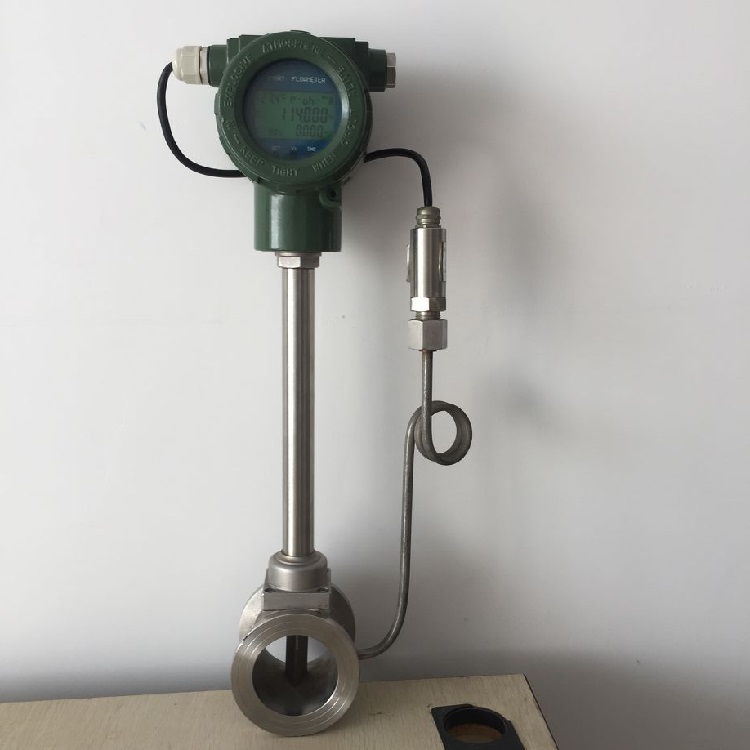Should the flow meter in the heat transfer oil heat meter be installed in the flow pipe or the return pipe? What is the impact on the measurement results? The operation principle of Guangzhou Dichuan Instrumental Thermal Oil Heat Meter is: the heat meter installed in the heat exchange system, when the heat carrier flows through the system, according to the flow given by the flow sensor, the oil given by the paired temperature sensor, back The oil temperature, as well as the time the heat carrier heat transfer oil flows, is calculated by the calculator and displays the amount of heat released or absorbed by the system. The basic formula is: Where Q is the heat released by the heat meter in the heat exchange system, in units of KJ ; Qm—— mass flow rate of heat transfer liquid flowing through the heat meter, unit KG/S ; Δh—— the ratio of the enthalpy difference of the heat transfer liquid corresponding to the inlet temperature and the outlet temperature in the heat exchange system, unit KJ/KG ; t - time, unit s . From this equation, in a heat exchange system, heat is the integral of the change in the enthalpy of the influent and return water of the heat exchange system during time t . The enthalpy value depends on the temperature, pressure and specific heat capacity of the heat carrier. The original physical quantity that can be measured by a heat meter is the temperature and flow rate of the heat carrier, and the flow meter measures the volume flow rate, not the mass flow rate. Moreover, the specific gravity of the heat carrier varies with temperature, so it must be To make corrections, this leads to another calculation formula, as follows: Where Q is the heat released by the heat meter in the heat exchange system, in units of J or KW.H ; V—— the cumulative volume flow of the superheat energy meter of the heat transfer liquid flow, in m3 ; Δθ— the temperature difference at the inlet and outlet of the heat transfer liquid in the heat exchange system, in °C ; K—— thermal coefficient, which is a function of the heat transfer liquid under the corresponding temperature, temperature difference and pressure, in units of J/m3 or KW.H/m3 °C This formula is the "K- factor calculation method " . The K factor is divided into the oil heat coefficient and the oil return heat coefficient. Its physical meaning is: the heat released per one cubic degree of heat carrier per cubic meter of heat carrier in the oil inlet or return port after flowing through the heat exchange system . So far, the European advanced level of heat meter products and design reports have been used to correct the measurement accuracy by using the K- factor method. Obviously, the value of the K factor depends on the volume of the heat meter. The flow meter is installed in the system of the inlet or the return port. Even under the same temperature difference, the installation position of the volume flowmeter must be studied. Let us give an example: when the inlet temperature is 70 degrees, the return port temperature is 30 degrees, and the pressure is 16 bar , when the flowmeter is installed on the return line, K=1.156462 (the European standard calculation result is 1.1565) ), and when installed on the inlet pipe to the upper calculation, K = 1.135530 , the difference is close to 2% . If the inlet pipe temperature is 130 degrees and the return pipe temperature is 70 degrees, the error can reach 4.4% , which obviously exceeds the allowable error range. Therefore, when the K- factor method is used to calculate the heat, there is a strict requirement for the installation position of the flow meter, and the installation on the oil discharge pipe cannot be easily installed on the oil return pipe. Guangzhou Dichuan Instrument & Meter Co., Ltd. is mainly engaged in the research and development and production of flow meters. Mainly engaged in: electromagnetic flowmeter, vortex flowmeter, turbine flowmeter, V- cone flowmeter, rotameter, sewage flowmeter, electromagnetic flowmeter, turbine flow Meter, vortex flowmeter, ultrasonic flowmeter, MF type gas flowmeter  , FS series micro-miniature flowmeter, gas mass flowmeter, sewage flowmeter, gear flowmeter, environmental analysis instrument COD ammonia nitrogen instrument  Dissolved oxygen instrument, PH meter, conductivity, resistivity, residual chlorine  Dichuan Instrument, such as secondary water supply analysis system, has won extensive market support with domestic leading technical level and perfect after-sales service. We sincerely invite customers to come to discuss cooperation and are willing to work with you to win the future.
Nylon Membrane (N6/N66)
Application:
Specification:
Nylon Filter Membrane,Nylon Filter Paper Disc,Hydrophilic Nylon Membrane,Nylon Filter Material Ji'an city Qing Feng Filter Equipment Material CO.,Ltd , https://www.qingfengfilter2.com
1.With imported non-textile supporting bolster, good resilience, torn-u tolerance and durability
2.Intense filtration and high filtration quality
3.Naturally hydrophilic. No need to use humectant, which prevents the filtrate from being contaminated.
4.Applies to water solvent and most organic solvent, especially to the filtration of alkalinity and alcohol solvent.
5.Nylon66 Membrane has higher mechanical strength, higher temperature resistance, better low temperature resistance.
2.Filtration of various solvent and medication solvent.
3.Filtration of corrosion- resistance
4.Ultimate filtration of ink
Sterilization: Non-Sterilization packaging; High temperature and high pressure sterilization 121 ° C for 30 minutes,
Shape Size(mm): Disc Membrane : Φ13.Φ25.Φ35.Φ47.Φ50.Φ60.Φ77.Φ90.Φ100.Φ150.Φ200.Φ300:
Square Membrane: Can be customized. Max Size: 400 * 300
Roll Membrane: The width : 280.320.420mm; the length can be customized.